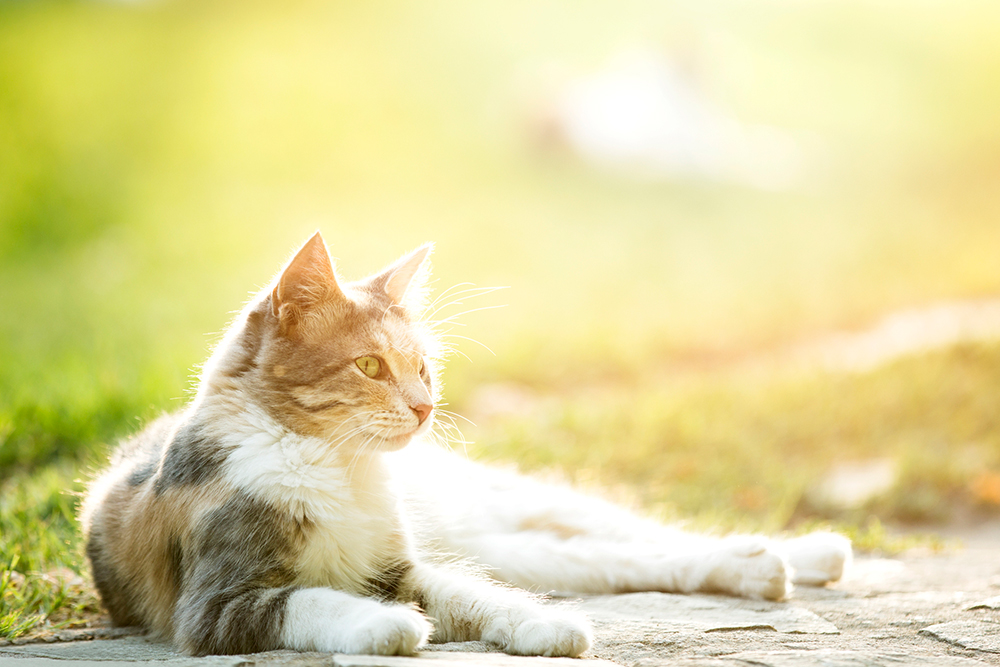Understanding Heat Stroke in Cats and How to Prevent It
Cats love to explore outside and take in the world around them. During warmer months, it is important to make sure your cat stays as cool as possible. Many breeds of cats have fur that can make it hard to decrease their body temperature in hot weather. When a cat becomes severely overheated, it can have a heat stroke which can turn into a serious medical condition if left untreated.
When a cat is experiencing a heat stroke their internal body temperature has risen to above 104 degrees Fahrenheit. With an internal temperature that high, organs begin to shut down and long-term damage can occur. Luckily, there are things you can do to help prevent heat stroke in cats and still allow them to enjoy the warmer months outside.

The Difference Between Heat Exhaustion and Heat Stroke in Cats
Any time your cat becomes overheated, it can be cause for concern. However, there are different levels of emergencies. Knowing the difference between heat exhaustion and heat stroke in cats can help you decide whether or not you need to seek medical attention for your cat.
Heat exhaustion occurs before heat stroke. Similar scenarios can cause both heat exhaustion and heat stroke, but the symptoms are different for the two conditions. Heat exhaustion is when a cat has become overheated but their body still has time to recover.
A cat’s normal body temperature ranges from 99-102 degrees Fahrenheit. If a cat is experiencing heat exhaustion it is likely on the upper end of that range. Heat exhaustion can lead to heat stroke if the cat is not removed from the hot environment and given measures to help cool their body down.
Type of Cats That Are Prone to Heat Stroke
While any type of cat can experience heat stroke, there are certain breeds and conditions that are more prone to the condition. Two cat breeds that are more likely to deal with heat stroke are the Persian and Himalayan breeds. These two breeds have a longer and thicker coats of fur which means their bodies have a harder time cooling off as efficiently as other breeds.
Overweight cats are also more likely to experience heat stroke. Making sure your cat eats a healthy diet and gets as much exercise as possible can help them lose weight and stay healthy during warmer months when the temperature is elevated outside.
Symptoms of Heat Stroke in Cats
Panting is one of the first symptoms a cat will exhibit if they are experiencing a heat stroke. The most obvious sign of heat stroke in a cat is an internal temperature of 104 degrees Fahrenheit or higher. To take your cat’s temperature, you need to use a rectal thermometer to get an accurate reading.
Other symptoms of heat stroke in cats can include rapid pacing as well as showing signs of intense anxiety such as meowing frequently. If your cat’s tongue or mouth is bright red those are also indicators of heat stroke.
Cats may drool and breathe heavily while experiencing heat stroke as their body is trying to cool themselves down as rapidly as possible. Vomiting and diarrhea are also symptoms of heat stroke in cats. With any of these symptoms combined, it is imperative to work to cool down your cat as quickly as possible and seek medical help.
Treatment for a Cat Experiencing Heat Stroke
The most important thing to do when treating a cat with heat stroke is to immediately begin working to cool their body temperature. However, this needs to be a slow process to help the body adjust. Bring your cat to a cool environment and offer water. If they don’t want to drink right away, don’t panic.
Keep offering the water every few minutes while working on other ways to cool them down. Putting a fan in front of your cat may help in trying to cool their body down. You can also use cool, wet towels on their body. Make sure not to wrap the towel around them as this can actually trap the heat you are trying to release.
How to Prevent Heat Stroke in Cats
One of the most important things you can do to help prevent heat stroke in cats is to make sure your cat stays hydrated. When animals become dehydrated their body temperature naturally rises. When a cat is already overheated and dehydrated that can be a recipe for disaster. Provide different water bowls both inside and outside for your cat. During the warmer months, encourage them to drink as often as possible.
It is also imperative that you check on your cat at least once, if not twice, a day. When a cat is experiencing heat stroke they can become extremely lethargic and sedentary and it can be hard to locate them if they have been outside.
Keeping an eye out for your cat throughout the day can help you be aware of any early symptoms they might be experiencing of heat exhaustion. Cats can also get themselves stuck in small spaces where they can’t escape leading to heat exhaustion and dehydration. Also make sure not to leave your cat in a hot car during the warmer months as that can easily lead to a cat being overheated.
Summary of Cat Heat Stroke
Remember that there is a difference between heat exhaustion and heat stroke in cats. Heat exhaustion can typically be treated at home if caught early whereas heat stroke likely means a visit to your veterinarian. There are things you can do to prevent heat stroke in cats such as offering water often on days with higher temperatures and being aware of where your cat is spending time during the warmer months to make sure they have a place to cool down.
If you are concerned your cat may be overheated, work to cool their body down slowly and encourage them to drink water. Keeping a close eye on your cat during the warmer months can help prevent heat stroke and help you and your cat be able to enjoy the warm weather together.
If you believe your cat is experiencing heat stroke in Montgomery, AL, contact Montgomery Veterinary Associates. We are here to help!






